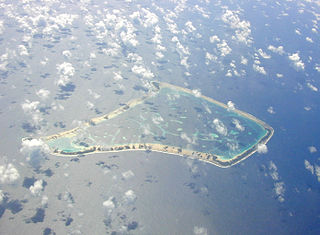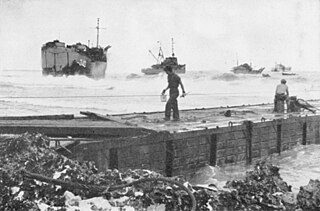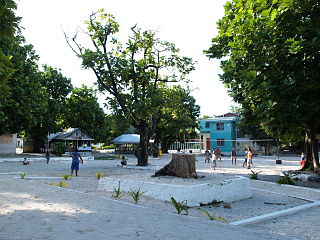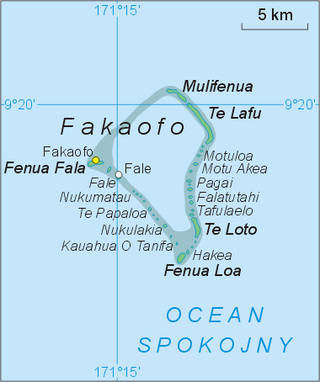Related Research Articles

Tokelau is a dependent territory of New Zealand in the southern Pacific Ocean. It consists of three tropical coral atolls: Atafu, Nukunonu, and Fakaofo. They have a combined land area of 10 km2 (4 sq mi). The capital rotates yearly among the three atolls. In addition to these three, Swains Island, which forms part of the same archipelago, is the subject of an ongoing territorial dispute; it is currently administered by the United States as part of American Samoa. Tokelau lies north of the Samoan Islands, east of Tuvalu, south of the Phoenix Islands, southwest of the more distant Line Islands, and northwest of the Cook Islands.

Fakaofo, formerly known as Bowditch Island, is a South Pacific Ocean atoll located in the Tokelau Group. The actual land area is only about 3 km2, consisting of islets on a coral reef surrounding a central lagoon of some 45 km2. According to the 2006 census 483 people officially live on Fakaofo. Of those present 70% belong to the Congregational Church and 22% to the Catholic Church.

Nukunonu is the largest atoll within Tokelau, a dependency of New Zealand, in the south Pacific Ocean. It comprises 30 islets surrounding a central lagoon, with about 5.5 km2 (2.1 sq mi) of land area and a lagoon surface area of 109 km2 (42 sq mi). Motuhaga is the only islet that has inhabitants. It has an estimated population of 448.

The office of head of government of Tokelau, often simply called the Ulu, rotates yearly between the faipule (leaders) of Tokelau's three atolls: Atafu, Fakaofo, and Nukunonu. The current Ulu is Siopili Perez, the Faipule of Nukunonu atoll, who has held the position since May 2022.

USS LST-340 - later known as USS Spark (IX-196) - was a LST-1-class tank landing ship that served with the U.S. Navy during World War II. LST-340 served in the Pacific theatre and, despite suffering severe damage from the enemy, was awarded three battle stars for her action in dangerous areas. She was declared too damaged to return to the United States, so she was then reassigned as a barracks ship at Saipan.
Mulifenua is an islet of the Fakaofo island group of Tokelau.
Matangi is an islet of the Fakaofo island group of Tokelau.
Saumatafanga is an islet of the Fakaofo island group of Tokelau.
Fenua Loa is an islet of the Fakaofo island group of Tokelau.
Nukulakia is an islet of the Fakaofo island group of Tokelau.
Nukumatau is an islet of the Fakaofo island group of Tokelau.
Teafua is an islet of the Fakaofo island group of Tokelau.

Fenua Fala is an islet of the Fakaofo island group of Tokelau. A settlement Fakaofo was established there in 1960.

Fale is an islet of the Fakaofo island group of Tokelau. The main settlement in the group is located on the island. As of 2018, 355 people lived on the islet.
Sāvaia is a village on the island of Upolu in Samoa. It is situated on the south west coast of the island and is part of the Lefaga ma Faleaseela Electoral Constituency which forms part of the larger A'ana political district.

Koshava Island is the easternmost island in the Zed group off Varna Peninsula, northeastern Livingston Island in the South Shetland Islands, Antarctica. The island is ice-free, extending 340 by 220 m. Situated on the west side of the north entrance to McFarlane Strait, 140 m (150 yd) northeast of Lesidren Island, and 1.9 km (1.2 mi) north of Williams Point on Livingston Island. The area was visited by early 19th century sealers.
Awtano is a member of the Fakaofo island group of Tokelau.
The 196th Infantry Division was an infantry division of the German Heer during World War II.

The Western Polynesian tropical moist forests is a tropical and subtropical moist broadleaf forests ecoregion in Polynesia. It includes Tuvalu, the Phoenix Islands in Kiribati, Tokelau, and Howland and Baker islands, which are possessions of the United States.
References
Coordinates: 9°20′24″S171°11′46″W / 9.340°S 171.196°W